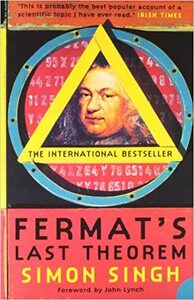Take a photo of a barcode or cover
I genuinely thought I was buying a fiction book when I bought it. Turns out I was dead wrong. This is one of the best non-fiction book I read this year. It started with a simple theorem: alike Pythagorean Theorem, but immensely difficult to proof. This book tells the story of how Andrew Wiles, a mathematician from Princeton who proved Fermat's Last Theorem. Structurally, the book explains the development of mathematics from the Ancient Greece to today. It started with Pythagorean theorem, and then to Diophantus, whose book, Arithmetica becomes a guide for the amateur mathematician, Fermat. This book also delves into the live of Fermat, and different mathematicians whose whole lives tried to prove Fermat's Theorem. In addition to explaining the development of mathematics historically, Singh is also able to create a mathematical narrative that seems "understandable" for layperson like me. This is a very good read and I'd recommend it to everyone!
informative
inspiring
medium-paced
A great account of how the works of people around the world, spanning centuries, came together to culminate in the proof of Fermat's famous last theorem. I've never been this engrossed in a book about the history of mathematics - Simon Singh gives just the right amount of background for each piece of the puzzle, takes us through the roller-coaster ride of emotions the mathematicians went through, and then brings it all together quite beautifully.
This book is more about the people behind the proof and the epic scale of the journey towards it, than the technicalities of the proof itself. I personally loved this approach. It was refreshing to put actual people behind the names I've seen over the years in education. Textbooks often skip straight to the end, but I find it's easier to appreciate the beauty of the result if you knew what it took to get there, and this account bridges the gap if you were to then go for a more technical source to get into the details. Enough explanation of each development is given to follow along and understand the role they played, but some previous understanding of basic number theory and proof techniques would make it a more enjoyable read. There's lots of anecdotes, my favourites being the ones about Euler - especially the one where he lost sight in both eyes, said "Now I will have less distraction", and continued to be more productive than ever before. Absolute legend.
If I had read this book back in school, who knows? I might have taken math in uni.
(my first ever review haha :))
This book is more about the people behind the proof and the epic scale of the journey towards it, than the technicalities of the proof itself. I personally loved this approach. It was refreshing to put actual people behind the names I've seen over the years in education. Textbooks often skip straight to the end, but I find it's easier to appreciate the beauty of the result if you knew what it took to get there, and this account bridges the gap if you were to then go for a more technical source to get into the details. Enough explanation of each development is given to follow along and understand the role they played, but some previous understanding of basic number theory and proof techniques would make it a more enjoyable read. There's lots of anecdotes, my favourites being the ones about Euler - especially the one where he lost sight in both eyes, said "Now I will have less distraction", and continued to be more productive than ever before. Absolute legend.
If I had read this book back in school, who knows? I might have taken math in uni.
(my first ever review haha :))
Fascinating and gripping read. Part mystery, part tragedy, part celebration of the human spirit. Highly recommend it and no you don't really need to know or understand anything about maths.
so inspiring. i want to be him and every other mathematician in this story
Consistently engaging without ever feeling condescending; I lost track of the maths about halfway through, but I suppose that was inevitable. Singh gradually resorts more to analogy than to accurate description of the work involved: again, inevitable, but sometimes some clarity is lost.
This book makes mathematics both understandable and interesting! It is an incredibly well-told story about the nature of mathematics and mathematicians and the search for the proof of Pierre Fermat's last theorem. It explains what the theorem is and the nature of mathematical proof and it comes as close as imaginably possible to explaining how mathematical techniques and knowledge developed until a proof of the theorem could be devised.
Pythagoras's famous equation ("for a right-angled triangle, the square on the hypotenuse is equal to the sum of the squares on the other two sides") leads to a simple mathematical equation. Pierre Fermat, in 1637 or thereabouts, wondered whether you could have an equivalent equation using cubes rather than squares, or indeed any higher power. He claimed, in a marginal note, that "I have discovered a truly marvellous proof of this, which this margin is too narrow to contain". But in the ensuing 350 years no mathematician could prove 'Fermat's Last Theorem' (last because it was the last to be confirmed). Then, in 1993, Andrew Wiles claimed to have a proof. But did he?
This book is stuffed with brilliant anecdotes and wonderful curiosities from the world of mathematics,
Pythagoras's famous equation ("for a right-angled triangle, the square on the hypotenuse is equal to the sum of the squares on the other two sides") leads to a simple mathematical equation. Pierre Fermat, in 1637 or thereabouts, wondered whether you could have an equivalent equation using cubes rather than squares, or indeed any higher power. He claimed, in a marginal note, that "I have discovered a truly marvellous proof of this, which this margin is too narrow to contain". But in the ensuing 350 years no mathematician could prove 'Fermat's Last Theorem' (last because it was the last to be confirmed). Then, in 1993, Andrew Wiles claimed to have a proof. But did he?
This book is stuffed with brilliant anecdotes and wonderful curiosities from the world of mathematics,
informative
inspiring
fast-paced
emotional
informative
inspiring
lighthearted
medium-paced
A great example of how to talk about a scientific topic to the general public. A tour de force spanning centuries of mathematical (and non) history, without a single boring section. Every bit of maths needed to get closer to the climax is well introduced and made interesting for potentially anyone. This is mixed with some great drama voiced by the people directly involved in this 300+ year long story, be it through letters, curious emails or direct interviews. It also shines some light into the process of doing math/science with some great one-liners that I've found personally relevant.
A lesson in scientitic dissemination.
A lesson in scientitic dissemination.
It's crazy how the Taniyama–Shimura can play such an importance in morden day maths. Unification of different areas in my eyes only build towards a more accurate image of the world. Plus the history of the problem is wonderfully entertaining.



